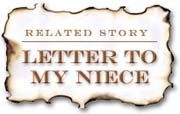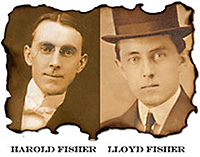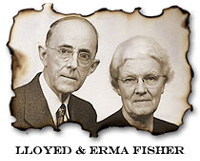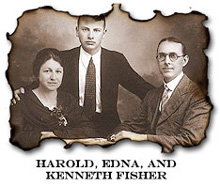BY KAREN FISHER
 LTHOUGH it was already December 30, 1902, the streets and yards of Battle Creek, Michigan, were without snow. A slight breeze blew from the south. Shortly after 7:20 that Tuesday evening, the Tabernacle church bells rang to call the congregation to prayer meeting. Worshipers greeted each other warmly as they hurried toward the Tabernacle.
LTHOUGH it was already December 30, 1902, the streets and yards of Battle Creek, Michigan, were without snow. A slight breeze blew from the south. Shortly after 7:20 that Tuesday evening, the Tabernacle church bells rang to call the congregation to prayer meeting. Worshipers greeted each other warmly as they hurried toward the Tabernacle.
Two brothers, Lloyd and Harold Fisher, entered and took their seats. After working all day at the Review and Herald Publishing House, they looked forward to some spiritual refreshment. Serious-minded Lloyd had begun his career with the Review in September of 1901, a month before his eighteenth birthday. His younger brother Harold, an outgoing 17-year-old, was a new apprentice.
The prayer meeting had scarcely begun when the Tabernacle door flew open, and a red-faced intruder yelled: "I hate to interrupt, but the publishing house is on fire."
 Lloyd and Harold jumped to their feet and joined the sudden exodus to the sidewalk. Across the street, angry flames raged through the publishing house. In stunned silence the two brothers watched the 40,000-square-foot building burn from the back to the front. At 8:00 the roof fell in. By 8:30 the brick-veneered walls collapsed into the street.
Lloyd and Harold jumped to their feet and joined the sudden exodus to the sidewalk. Across the street, angry flames raged through the publishing house. In stunned silence the two brothers watched the 40,000-square-foot building burn from the back to the front. At 8:00 the roof fell in. By 8:30 the brick-veneered walls collapsed into the street.
Within an hour all that remained of the Review and Herald plant was the West Building, located across the street from the main building. It housed the Review bank, the book depository, and the General Conference offices. The direction of the wind saved it from serious damage.
The first concern of the Review and Herald board was for the welfare of its 300 employees. At a meeting the next morning, the workers were assured that none would be allowed to suffer. Some would be given work at the Battle Creek Sanitarium, some at other publishing houses. Books stored in the book depository would supply those who wished to sell door to door. For a while only a skeleton crew would remain with the Review and Herald.
Almost before those smoking embers cooled, new printing machinery was ordered to be installed in the West Building. At the same time, editors of the main church paper, The Advent Review and Sabbath Herald (affectionately known as the Review) began the task of compiling copy for the January 6 issue. Providentially, the December 30 issue was already in the mail.
Until their new equipment was operational, the type for the next few issues was set in the offices of three newspapers in Battle Creek and then printed on the presses of another printing establishment.
 In mid-July of 1903 the decision was made to move the Review and Herald publishing plant and the General Conference offices to Washington, D.C. A building located a few blocks from the Capitol was rented to house the two entities until the new plant and headquarters would be completed in 1906.
In mid-July of 1903 the decision was made to move the Review and Herald publishing plant and the General Conference offices to Washington, D.C. A building located a few blocks from the Capitol was rented to house the two entities until the new plant and headquarters would be completed in 1906.
The last issue of the Review printed in Battle Creek was dated Tuesday, August 11, 1903. On August 10 four carloads of General Conference furniture and Review and Herald equipment arrived in Washington, D.C., by train, and a handful of workers took occupancy of the rented building. On August 11 incorporation of the Review and Herald Publishing Association became effective in the District of Columbia.
Somehow in the midst of the many details to be attended to, the next issue of the Review bore the dateline: Washington, D.C., Thursday, August 20, 1903. Only a two-day interval interrupted the regular rhythm of the arrival of the beloved Review.
Lloyd and Harold, along with other loyal Review and Herald employees, soon made their way from Battle Creek to Washington, D.C. Lloyd was a Linotype operator known for his ability to catch errors while reading copy backward--even punctuation errors. Harold, mechanically gifted, worked as a pressroom foreman.
 The two brothers married two sisters from Battle Creek, Erma and Edna Paul--Erma, a nurse, and Edna, a teacher. They purchased an acre of land at 33 Woodland Avenue in Takoma Park, near the new Review and Herald plant, and divided it into two parcels.
The two brothers married two sisters from Battle Creek, Erma and Edna Paul--Erma, a nurse, and Edna, a teacher. They purchased an acre of land at 33 Woodland Avenue in Takoma Park, near the new Review and Herald plant, and divided it into two parcels.
Two bungalows ordered from the Sears and Roebuck catalog were built so close together that the couples could visit with each other as they sat on their respective screened-in back porches.
Each day Lloyd and Harold walked almost a mile to work. During lunch hour they walked home in 15 minutes, ate in 30, then walked back in the final 15.
This cycle continued until 1922, when Harold was asked to transport a printing press to Brazil. On arrival in that country, Harold unpacked parts and pieces from a dozen packing crates and sorted them into piles. The press was assembled and running within six weeks. For the next 15 years Harold served in the capacity of supervisor and then manager of the Brazil Publishing House.
 Lloyd maintained an unbroken work record with the Review and Herald Publishing Association, eventually being placed in charge of proofreading and copyediting and occasionally being used in an editorial capacity. When he retired after 47 years in 1949, he was earning a whopping $56 a week.
Lloyd maintained an unbroken work record with the Review and Herald Publishing Association, eventually being placed in charge of proofreading and copyediting and occasionally being used in an editorial capacity. When he retired after 47 years in 1949, he was earning a whopping $56 a week.
As Lloyd's sons, Paul and Willard, entered academy (high school), they found jobs wrapping Reviews in the mailroom and melting down lead for the linotype. The two boys and their double cousin, Kenneth, attended medical school in Loma Linda, California, but each carried a lifetime love and loyalty for the Review and Herald and its weekly church paper, the Review. For the Fisher family the Review was their mission and their life.
I'm told that Paul carried a folded Review in his back pocket in case a patient gave him a few minutes' wait. Willard read his Review with pen in hand, checking off each article as he read it--also correcting any rare mistake that he might find (he inherited his father's proofreading eye). Kenneth would have thought it a sin not to subscribe to the Review.
 Now we of the next generation carry on the family tradition. The Review has followed us for more than 30 years: from California to Florida to Botswana to Oregon to Pakistan and back to Oregon again. It doesn't feel like home until our subscription catches up with us. The Review also makes its weekly appearance in the homes of our children.
Now we of the next generation carry on the family tradition. The Review has followed us for more than 30 years: from California to Florida to Botswana to Oregon to Pakistan and back to Oregon again. It doesn't feel like home until our subscription catches up with us. The Review also makes its weekly appearance in the homes of our children.
Lloyd and Harold went to their rest many years ago; Paul and Kenneth have both followed in recent years. My husband's father, Willard, lives in an Alzheimer facility near our home. He doesn't know our names anymore, but his face still lights up when we hand him his weekly Review.
_________________________
Karen Fisher writes from Hermiston, Oregon.

